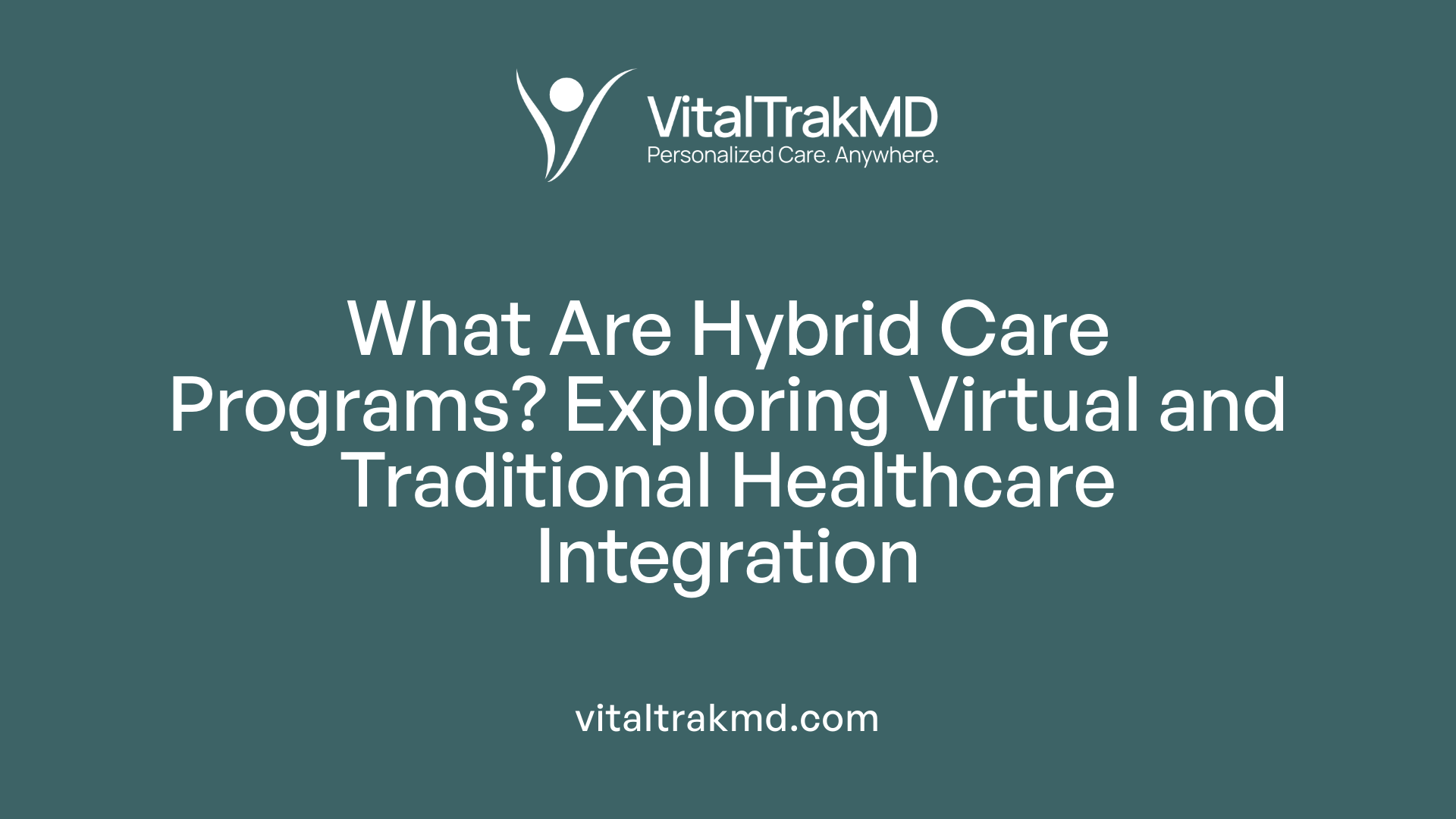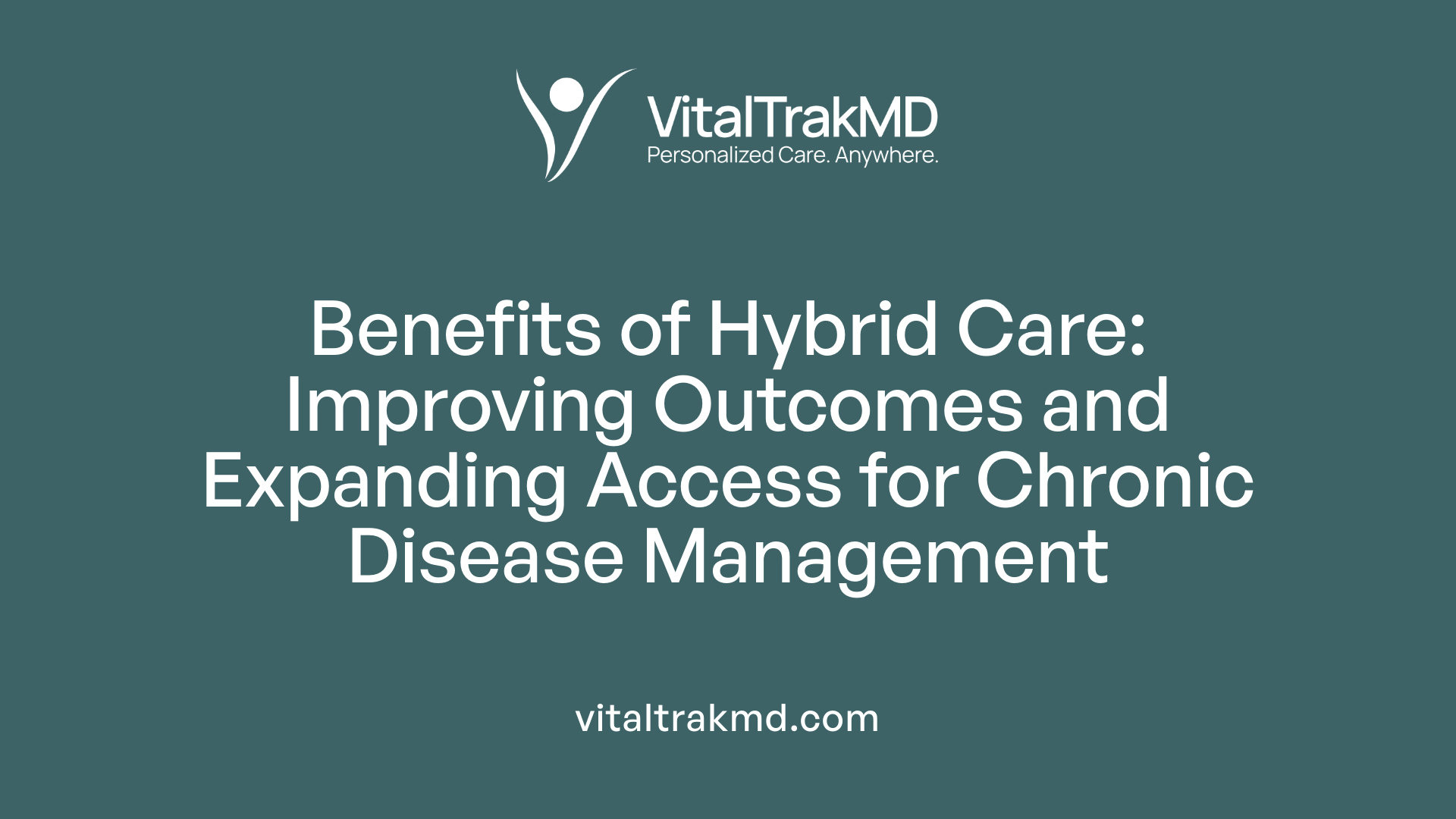Chronic Care Clinics vs Hybrid Care Programs

Understanding the Shifts in Healthcare Delivery Models
As the landscape of healthcare continues to evolve, understanding the distinctions between traditional chronic care clinics and innovative hybrid care programs becomes essential. This article explores these models, their features, benefits, implementation challenges, and prospects, providing a comprehensive overview for healthcare providers, policymakers, and patients alike.
Defining Chronic Care Clinics and Hybrid Care Programs

What is the meaning of hybrid care?
Hybrid care is an innovative healthcare delivery approach that blends virtual (telehealth) consultations with traditional in-person visits. This model is designed to offer patients more flexible and accessible care options by utilizing technology alongside physical healthcare settings.
In practice, hybrid care involves collaboration between patients and healthcare providers to determine which mode of treatment works best for each situation. For example, routine follow-ups or chronic disease management might be conducted remotely through telemedicine, while acute or complex cases may still require face-to-face visits.
The approach is especially beneficial for patients facing transportation issues, mobility limitations, or living in remote areas. It enables timely access to care, reduces waiting times, and can improve health outcomes through continuous monitoring and early intervention.
Implementing hybrid care involves several steps. Healthcare providers need to integrate new clinical workflows, ensure data privacy and security, and train staff to use digital tools effectively. Patients must be educated about how to access online platforms, prepare for virtual visits, and understand when an in-person visit is necessary.
Overall, hybrid care combines the strengths of both virtual and in-person healthcare, aiming to enhance patient satisfaction, improve care efficiency, and expand access to quality healthcare services.
Features and Components of Care Delivery Approaches

What are the features, components, and structures of different care models?
Care delivery models have evolved significantly to meet the diverse needs of patients and the healthcare system. Traditional models primarily relied on in-person visits within clinical settings. However, recent developments include hybrid models that combine in-person and virtual care, along with innovative structures like remote patient monitoring (RPM) and team-based management approaches.
In hybrid models, physical hospital beds are integrated with virtual beds—enabling care to extend into the home or community. This approach was exemplified by the Sheba Medical Center in Israel, which redesigned its internal medicine unit to include fewer physical beds and more virtual monitoring stations. Such structures allow for greater flexibility, expanded capacity, and seamless movement of patients between inpatient and remote care settings.
Chronic care management (CCM) emphasizes ongoing, coordinated care outside of traditional visits. It incorporates virtual or in-person check-ins, remote monitoring of vital signs, and self-management tools powered by digital technology. These components help manage conditions like diabetes, hypertension, COPD, and congestive heart failure more effectively.
Additionally, care models like the Integrated General Hospital (IGH) in Singapore link hospital services with community care, creating a continuum that reduces fragmentation and promotes holistic management. This includes disease prevention, rehabilitative care, and palliative services—all organized within an integrated, hospital-led framework.
How are digital tools integrated into these models?
Digital tools are essential to modern care models, particularly hybrid and chronic care approaches. Remote patient monitoring devices are used to track vital signs, medication adherence, and other health indicators—reducing hospital readmissions and supporting early intervention.
Telemedicine platforms facilitate virtual consultations, providing convenience and reducing transportation barriers. For example, LifeBridge Health’s Center for Virtual Care offers various telehealth services, including virtual primary care, diabetes management, and post-discharge follow-up. These platforms often integrate with electronic health records (EHRs), allowing real-time data sharing among care teams.
Patient engagement tools, like online portals, automated reminders, and digital communication channels, empower patients to participate actively in their care. Asynchronous telemedicine—where patients and providers communicate without live interaction—addresses provider shortages and streamlines low-acuity care.
Advanced digital innovations, including AI-driven analytical tools, smart sensors, and augmented reality (AR), are further enhancing hybrid models. They support continuous monitoring, personalized treatment plans, and remote therapeutic interventions.
How do different care models impact healthcare access and patient-centeredness?
Different care models profoundly influence healthcare access and how patients experience their care. Hybrid and chronic care models expand access by providing flexible, coordinated services that can be accessed remotely or at home, eliminating some barriers like transportation or scheduling conflicts.
These models prioritize patient-centered care by aligning treatment plans with individual preferences, cultural values, and specific health needs. Engaging patients and their families in decision-making, supported by digital communication tools and personalized education, fosters trust and adherence.
In essence, integrated models that emphasize flexibility, coordination, and digital engagement result in more equitable, responsive, and personalized healthcare. They promote better health outcomes by ensuring care is accessible, continuous, and tailored to each patient’s circumstances.
Benefits and Outcomes of Different Care Models

What are the benefits of hybrid care models for managing chronic conditions?
Hybrid care models have become increasingly popular as an effective approach for managing chronic health conditions. These models combine traditional in-person visits with virtual healthcare services, creating a flexible and patient-centered system. One of their main advantages is improved access to care. Patients who face transportation issues or mobility challenges can receive consistent monitoring and support without needing to visit healthcare facilities frequently.
Another benefit is enhanced patient engagement. Remote monitoring devices, telehealth platforms, and digital communication tools empower patients to be active participants in their health management. This ongoing interaction enables healthcare providers to detect issues early, adjust treatments swiftly, and prevent complications. For example, remote blood pressure monitoring helps manage hypertension proactively, reducing hospitalizations.
Cost savings are also significant. By reducing unnecessary clinic visits and hospital readmissions, hybrid models can lower overall healthcare expenses. Additionally, these models help overcome staffing shortages by leveraging telehealth for routine follow-ups and chronic disease management.
Healthcare systems using hybrid care can better allocate resources, improve care coordination, and extend services to underserved rural populations. Implementing digital health coaching, remote patient monitoring (RPM), and virtual consultations encourages continuity of care outside traditional settings.
The overall effect of hybrid care is a more adaptable, efficient, and patient-friendly healthcare delivery. It aligns with the shift toward value-based care by promoting better clinical outcomes, reducing costs, and addressing healthcare disparities. These models facilitate long-term management of chronic conditions like diabetes, COPD, and heart failure, supporting healthier aging and improved quality of life.
Effectiveness and Outcomes of Care Models
How does telehealth and digital tools support hybrid care programs?
Telehealth and digital tools play a crucial role in enhancing hybrid care approaches by enabling seamless remote monitoring and virtual consultations. These technologies make healthcare more accessible and convenient, especially for older adults and those in underserved areas.
Remote monitoring devices track vital signs and health data, allowing healthcare providers to intervene early and manage chronic conditions effectively. Virtual consultations facilitate ongoing patient-provider communication without the need for physical visits, reducing wait times and transportation barriers.
Digital engagement tools, like mobile apps and online education platforms, empower patients to participate actively in their care plans. Automated reminders, virtual check-ins, and experience surveys foster continuous engagement and adherence to treatment.
Integrating clinical content that is evidence-based guarantees safety and medication adherence, boosting the quality of virtual care. This technological integration creates a flexible, patient-centered care environment that complements in-person services.
Overall, these digital tools support personalized care pathways, improve health outcomes, and promote operational efficiencies for healthcare systems.
Comparative effectiveness of clinics and hybrid models
Research indicates that hybrid care models, which combine in-person and virtual elements, can improve access and patient satisfaction while maintaining or enhancing health outcomes. For example, hybrid programs targeting chronic disease management—such as diabetes, hypertension, and COPD—have demonstrated reductions in hospital readmissions and emergency visits.
A study published in Nursing Economics revealed that integrating TCM into rural CCM programs decreased hospital readmissions and increased healthcare practice revenue. Similarly, programs like LifeBridge Health’s Center for Virtual Care expanded services, resulting in better remote patient monitoring and fewer hospital visits.
In comparison, traditional clinics relying solely on in-person visits often face limitations in access, wait times, and provider shortages. While traditional settings effectively deliver acute care, hybrid models excel at providing continuous, coordinated chronic care outside formal facilities.
Patient outcomes and hospital readmission rates
One of the most significant benefits of hybrid care is the positive impact on patient outcomes, especially in reducing hospital readmissions. Remote patient monitoring has shown to decrease all-cause hospitalizations for COPD patients by 65% and ER visits by 44.3%. For heart failure patients, early vital sign monitoring prevents relapses and readmissions.
Furthermore, hybrid models have contributed to measurable reductions in invasive procedures, medication use, and imaging, leading to cost savings and improved quality of life. For instance, early physical therapy in hybrid care settings has resulted in a 46% reduction in spine surgeries and a 50% decrease in emergency room utilization.
The combination of virtual and in-person care fosters better disease control, enhances patient engagement, and promotes adherence, culminating in improved overall health outcomes and lower hospital readmission rates.
| Aspect | Outcomes | Additional Details |
|---|---|---|
| Telehealth Tools | Improved access, personalized care | Remote monitoring, patient engagement apps |
| Chronic Disease Management | Reduced hospital readmission, better control | COPD, CHF, diabetes, hypertension |
| Patient Satisfaction | Increased satisfaction & experience | Flexible scheduling, reduced travel |
| Outcomes | Fewer emergency visits, lower invasive procedures | Early intervention, continuous monitoring |
| Cost Benefits | Cost reduction, increased revenue | Decreased hospital stays, virtual billing |
This evolving landscape demonstrates that digital-supported hybrid care models not only match traditional care in effectiveness but often surpass it in managing chronic illnesses and providing patient-centered services. As technology continues to advance, hybrid approaches are poised to become the standard for comprehensive, efficient, and accessible healthcare.
Implementation Challenges and Considerations
What are the challenges and considerations in implementing hybrid care approaches?
Implementing hybrid care models involves a variety of hurdles that healthcare providers must address to ensure effective delivery. One of the primary challenges is integrating different digital tools, such as telehealth platforms, patient monitoring devices, and electronic health records, into existing workflows. This integration often faces technical issues like interoperability, data security, and privacy concerns that need careful management.
Organizational and workflow changes are also significant. Moving to a hybrid model requires staff to adapt to new operational processes, which might meet resistance or require additional training. Workforce shortages, especially in rural or underserved areas, complicate efforts to scale these services.
Patient engagement and digital literacy are critical considerations. Not all patients may be comfortable using new technologies, and disparities in access to high-speed internet or devices can hinder the reach of virtual care.
Regulatory and reimbursement policies also present obstacles. Variability in telehealth coverage, licensing restrictions, and unclear billing practices can impact program sustainability.
To navigate these challenges, healthcare organizations must invest in flexible, secure technological infrastructure and prioritize staff training to handle hybrid systems efficiently. Policy advocacy for supportive reimbursement models and privacy safeguards is essential. Strong leadership, stakeholder collaboration, and ongoing evaluation help ensure that hybrid care models remain sustainable, scalable, and capable of delivering high-quality, patient-centered care.
Developing comprehensive strategies to address these issues facilitates smoother implementation of hybrid approaches, ultimately expanding access and improving outcomes in diverse healthcare settings.
Future Prospects, Policy, and Scalability of Hybrid and Chronic Care Models

What are the future prospects and policy considerations for hybrid and chronic care models?
The outlook for hybrid and chronic care models is overwhelmingly positive, driven by rapid technological advancement and changing healthcare demands. These models are expected to see widespread adoption, leveraging digital health solutions such as remote patient monitoring, telemedicine, and hospital-at-home programs. These innovations aim to enhance patient access, engagement, and coordination of care, especially for those with multiple chronic conditions.
Policy considerations are pivotal to this growth trajectory. Standardizing definitions and protocols for hybrid care will ensure consistency and quality across providers and systems. Addressing the digital divide is essential, as disparities in technology access could undermine the equity goals of these models.
Reimbursement reform is equally important. Current payment structures often favor traditional in-person visits, whereas hybrid models demand flexible, inclusive reimbursement strategies that support telehealth, RPM, and other virtual services. The integration of these models into existing healthcare frameworks will require adjustments in policy to incentivize comprehensive, patient-centered care.
Technological and design innovations will continue to evolve, creating more adaptable, personalized healthcare pathways that blend virtual and physical care seamlessly. This integration promises improved health outcomes, optimized resource use, and reduced costs.
Furthermore, safeguarding patient privacy and safety remains paramount. Developing robust regulatory frameworks, quality measures, and evidence-based standards will underpin the sustainable scaling of hybrid care.
Ultimately, policy environments that promote innovation, ensure equitable access, and support sustainable financial models will facilitate the broader integration of hybrid healthcare approaches. Such strategies will help address ongoing workforce shortages and infrastructural challenges, making healthcare more accessible, efficient, and responsive to future needs.
Embracing the Hybrid Future in Healthcare
The landscape of chronic disease management is set to undergo a transformation driven by technological innovation, changing patient expectations, and policy shifts. While traditional chronic care clinics continue to play a vital role, hybrid care programs emerge as a resilient, flexible, and patient-centered alternative that can address current healthcare challenges. By integrating virtual and in-person services, these models foster improved access, better clinical outcomes, cost savings, and enhanced patient satisfaction. Successfully navigating implementation challenges through strategic planning, stakeholder engagement, and policy support will unlock the full potential of hybrid care. Looking ahead, the future of healthcare will likely be characterized by a seamless blend of digital and physical care, ensuring sustainable, scalable, and equitable management of chronic conditions for diverse populations.
References
- Comparing In-Person Only, Telemedicine Only, and Hybrid Health ...
- Transitional Care Management Hybrid Approach to Chronic Care ...
- How the Hybrid Care Model is Transforming Patient Access
- The Complete Guide to Chronic Care Management
- Designing for flexibility in hybrid care services: lessons learned from ...
- Telehealth and the Future of Hybrid Care - Oliver Wyman
- More hybrid virtual care and asynchronous telemedicine on the way ...
- What is Hybrid Patient Care Model in Healthcare: Full Guide
Recent articles
Want to Feel Better and Live Healthier?
Join hundreds of patients taking control of their health with personalized care that fits their life – not the other way around.
Rated 4.8/5 by 32+ customers







